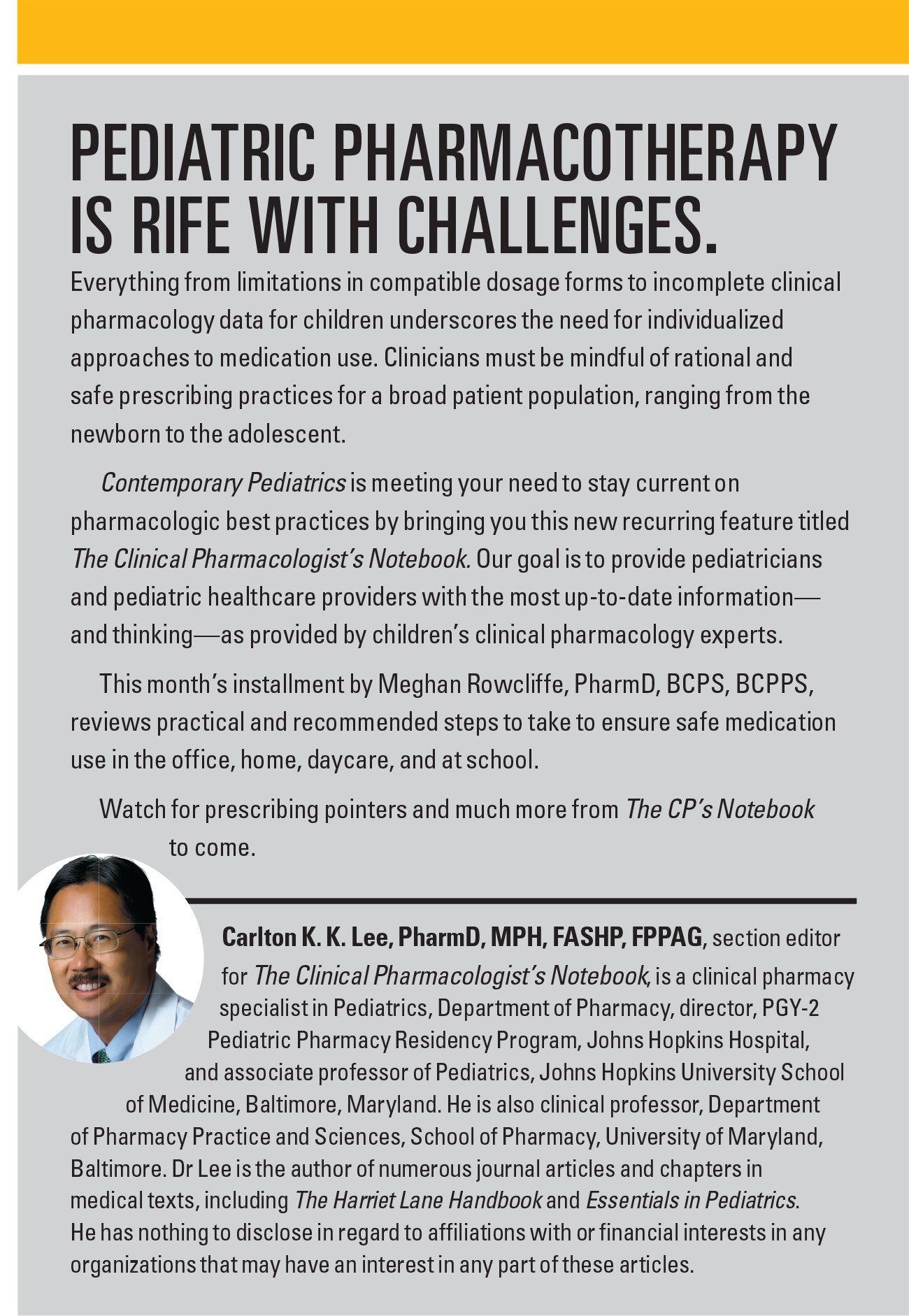Let’s all stop making medication errors in kids
Physicians, parents/caregivers, and school personnel must ensure that children are not harmed by medication errors in the provider’s office, at home, or at school.
Meghan Rowcliffe, PharmD, BCPS, BCPPS

Pediatric pharmacotherapy is rife with challenges

As the start of another school year approaches, parents and their children are going through their checklist to prepare for that first day. Likely one of those check boxes includes a trip to the doctor for a checkup and possibly receiving some vaccines.
As we know, pediatric patients are at risk for medication errors in both the office setting and when patients are under the supervision of caregivers. Reported medication errors in children, to name a few. include wrong medications prescribed due to inadequate medication histories and/or look-alike/sound-alike characteristics; dose calculation errors attributable to availability of multiple concentrations of a medication; and wrong vaccine administrations. This article will review some steps that primary care providers (PCPs) can take to ensure safe medication use in the pediatrician’s office and at home, daycare, and at school, as needed.
Vaccine safety
The Institute of Safe Medication Practices (ISMP) recently published a 2-part series highlighting national vaccination errors.1,2 Among the vaccine errors reported to the ISMP National Vaccine Errors Reporting Program in 2017, the most prevalent were wrong vaccine, wrong dose, expired vaccines, and wrong age.
Wrong vaccine errors are attributable to similar generic vaccine names, abbreviations, and vaccine packaging.
Contributing factors associated with wrong dose or age errors include:
· Age-dependent formulations of the same vaccine (eg, DTaP vs Tdap)
· Unfamiliarity with indicated ages for vaccines
· Failure to verify the patient’s age prior to administration
· Unfamiliarity with dosing of vaccines.
Vaccines frequently implicated in these mix-ups are:1
· Diphtheria, tetanus, and/or pertussis vaccines
· Measles, mumps, rubella, and/or varicella vaccines
· Hepatitis A, hepatitis B, and combination vaccines
· Pneumococcal vaccines
· Influenza virus vaccines.
In the case of pneumococcal vaccines, at times there is confusion regarding what serotypes Prevnar 13 (PCV13) covers versus Pneumovax23 (PPSV23). The 23-valent product contains 12 of the serotypes included in PCV13 plus 11 additional serotypes and isn’t necessarily better than the 13-valent product because it covers more serotypes. The 13-valent product is conjugated, providing more immunological durability and better protection against those serotypes prevalent for meningitis, which the 23-valent product does not.
Certain conditions such as asplenia necessitate the need for both vaccinations.2 Errors also have been attributed to administering diluents without the reconstituted associated active vaccine component (eg, ActHIB) as well as administering only 1 component of a 2-component vaccine (eg, Pentacel).1
To mitigate vaccine errors associated with ordering, standardized protocols/order sets should be developed and orders should include the full generic name, brand name, and the Centers for Disease Control and Prevention (CDC) standard abbreviation of each vaccine. Categorizing vaccines by the associated age at which they should be administered can facilitate ordering the right vaccine and right dose for the right age.
Vaccine administration errors also can be mitigated with improved vaccine storage and staff education and training. Improved storage recommendations include separating adult and pediatric formulations of the same vaccine; separating vaccines with similar names/abbreviations; utilizing auxiliary labels to highlight vaccine diluents and 2-component vaccines; and keeping these components stored together when possible. In addition, use of barcoded medication administration should be encouraged when possible.3
Update patients’ medication lists
Children with chronic conditions often are at risk for fragmented care because of the multiple providers that they see. For PCPs and specialists, it’s imperative that patients’ medication lists stay up-to-date to prevent unintended consequences such as caregiver/patient confusion at home and potential errors upon admission to the hospital.
Obtaining an accurate patient history is time consuming, but eliciting help from a nurse or, ideally, a pharmacist can help ensure that the list reflects what children are prescribed and, more importantly, actually taking at home. Potential pitfalls in this process include errors associated with look-alike/sound-alike medications, duplication of therapy, and confusion about a patient’s dose given multiple concentrations available.
Risks associated with this were demonstrated by an error involving a pediatric patient prescribed phenytoin. Upon discharge from the hospital, the patient was prescribed 6 mL of a phenytoin 30-mg/5-mL solution to be given 3 times a day and provided with an oral syringe marked for 6 mL. The outpatient pharmacy, however, dispensed a 125-mg/5-mL solution with instructions to administer 1.4 mL 3 times a day. Two days later, the patient presented to the emergency department with signs of phenytoin toxicity, and the mother reported giving 6 mL per dose of the 125-mg/5-mL solution.4
To avoid potential confusion regarding a patient’s dose of an oral liquid, it is best to document the dose in mg amount instead of volume, and to only dispense a marked oral syringe if the product is being dispensed with it. There is also an effort nationally by the American Society of Health System Pharmacists to standardize available concentrations of oral liquids to help prevent such dosing errors.
Promote safe medication administration in school
The need for medication administration during the school day has increased significantly over the last decade for children with chronic conditions such as epilepsy, diabetes, attention-deficit/hyperactivity disorder (ADHD), food allergies, and asthma. Ideally medication administration while children are in school should be avoided if possible. This can be accomplished through use of long-acting formulations, for example.
When medication administration in school is necessary, preferably a school nurse should coordinate this, but as school budgets are limited, school nurses are becoming obsolete and there is increased risk of errors associated with unlicensed personnel administering medications.5 To mitigate risk, educate caregivers to label medication(s) and include an appropriate measuring device (eg, oral syringe) when necessary and instructions on when and how to administer.
To ensure proper labeling, the outpatient pharmacy may be willing to generate an extra label to be applied to the school supply of medication. Any changes in medication or dose should be communicated directly to applicable school staff. If providing the school with medication devices such as an asthma inhaler, an EpiPen, or an insulin pen, instructions should be provided as well as a demonstration, if possible, to ensure safe and effective use.5
With these risks in consideration, taking the necessary steps to ensure safe vaccine use, updated medication lists, and promoting safe medication administration in schools will help keep children safe in this new school year and beyond.
References:
1. Institute for Safe Medication Practices. ISMP National Vaccine Errors Reporting Program 2017 Analysis (Part 1): Vaccine errors continue with little change. Available at: https://www.ismp.org/resources/ismp-national-vaccine-errors-reporting-program-2017-analysis-part-i-vaccine-errors. Published June 14, 2018. Accessed July 19, 2018.
2. Centers for Disease Control and Prevention (CDC). Use of 13-valent pneumococcal conjugate vaccine and 23-valent pneumococcal polysaccharide vaccine among children aged 6-18 years with immunocompromising conditions: recommendations of the Advisory Committee on Immunization Practices (ACIP). MMWR Morb Mortality Wkly Rep. 2013;62(25):521-524. Available at: https://www.cdc.gov/mmwr/preview/mmwrhtml/mm6225a3.htm. Accessed July 19, 2018.
3. Institute for Safe Medication Practices. ISMP National Vaccine Errors Reporting Program Part II: Preparing for immunization activities and campaigns. Available at: https://www.ismp.org/resources/ismp-national-vaccine-errors-reporting-program-part-ii-preparing-immunization-activities. Published June 28, 2018. Accessed July 19, 2018.
4. Sharfstein J, Agrawa D, Jeffrey P. Phenytoin dosage. Pediatrics. 1998;102(5);1223.
5. Institute for Safe Medication Practices. Fewer school nurses leads to greater medication errors. Available at: http://www.consumermedsafety.org/medication-safety-articles/item/550-fewer-school-nurses-%E2%80%A8leads-to-greater-medication-errors. Published May 7, 2012. Accessed July 19, 2018.































